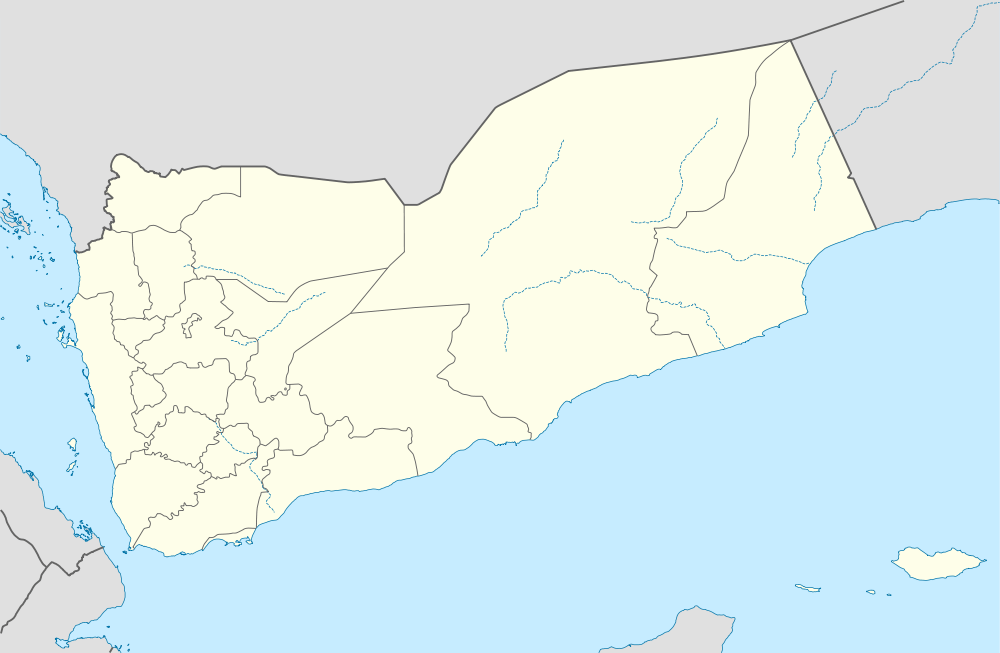Ash Shihr
| Ash Shihr | |
|---|---|
|
Northern gateway of Ash Shihr on a stamp issued in 1942 | |
 Ash Shihr Location in Yemen | |
| Coordinates: 14°45′39″N 49°36′25″E / 14.76083°N 49.60694°ECoordinates: 14°45′39″N 49°36′25″E / 14.76083°N 49.60694°E | |
| Country |
|
| Governorate | Hadhramaut |
| Time zone | Yemen Standard Time (UTC+3) |
Ash-Shihr (Arabic: الشحر) (transliteration al-Shiḥr) is a coastal town in Hadhramaut, southern Yemen. It is located at around 14°45′39″N 49°36′25″E / 14.76083°N 49.60694°E. It was a part of the Qu'aiti Sultanate before the unified Yemen was formed.
Ash Shihr was involved in the export of frankincense in ancient times, to be traded as far as China. The Chinese writer and customs inspector Zhao Rugua wrote on the origin of Frankincense being traded to China:
"Ruxiang or xunluxiang comes from the three Dashi countries of Murbat (Maloba), Shihr (Shihe), and Dhofar (Nufa), from the depths of the remotest mountains.[1] The tree which yields this drug may generally be compared to the pine tree. Its trunk is notched with a hatchet, upon which the resin flows out, and, when hardened, turns into incense, which is gathered and made into lumps. It is transported on elephants to the Dashi (on the coast), who then load it upon their ships to exchange it for other commodities in Sanfoqi. This is the reason why it is commonly collected at and known as a product of Sanfoqi."[2]
Ruxiang was the Chinese name for frankincense, and Dashi the Chinese name for Arabia.
References
- ↑ Ralph Kauz (2010). Ralph Kauz, ed. Aspects of the Maritime Silk Road: From the Persian Gulf to the East China Sea. Volume 10 of East Asian Economic and Socio-cultural Studies - East Asian Maritime History. Otto Harrassowitz Verlag. p. 130. ISBN 3-447-06103-0. Retrieved December 26, 2011.
The frankincense was first collected in the Hadhramaut ports of Mirbat, Shihr, and Zufar whence Arab merchant vessels shipped it to Srivijaya, before it was then reexported to China. The term "xunluxiang" is derived from the Arab word "kundur". . . According to Li Xun, frankincense originally came from Persia.92 Laufer refers to the Xiangpu fftff by Hong Chu %Ws (? . . . Zhao Rugua notes: Ruxiang or xunluxiang comes from the three Dashi countries of Murbat (Maloba), Shihr (Shihe), and Dhofar (Nufa), from the depths of the remotest mountains. The tree which yields this drug may generally be compared to the pine tree. Its trunk is notched with a hatchet, upon which the
- ↑ Ralph Kauz (2010). Ralph Kauz, ed. Aspects of the Maritime Silk Road: From the Persian Gulf to the East China Sea. Volume 10 of East Asian Economic and Socio-cultural Studies - East Asian Maritime History. Otto Harrassowitz Verlag. p. 131. ISBN 3-447-06103-0. Retrieved December 26, 2011.
resin flows out, and, when hardened, turns into incense, which is gathered and made into lumps. It is transported on elephants to the Dashi (on the coast), who then load it upon their ships to exchange it for other commodities in Sanfoqi. This is the reason why it is commonly collected at and known as a product of Sanfoqi.94
